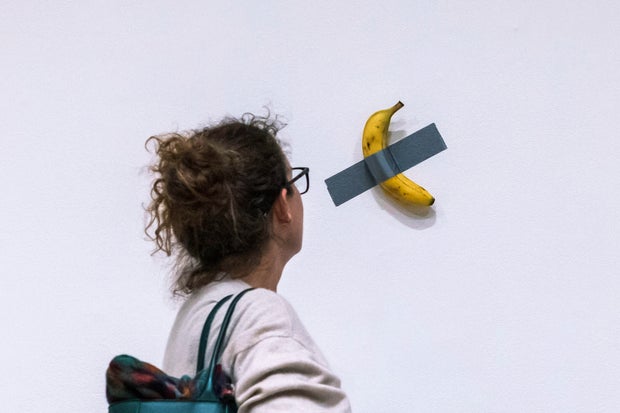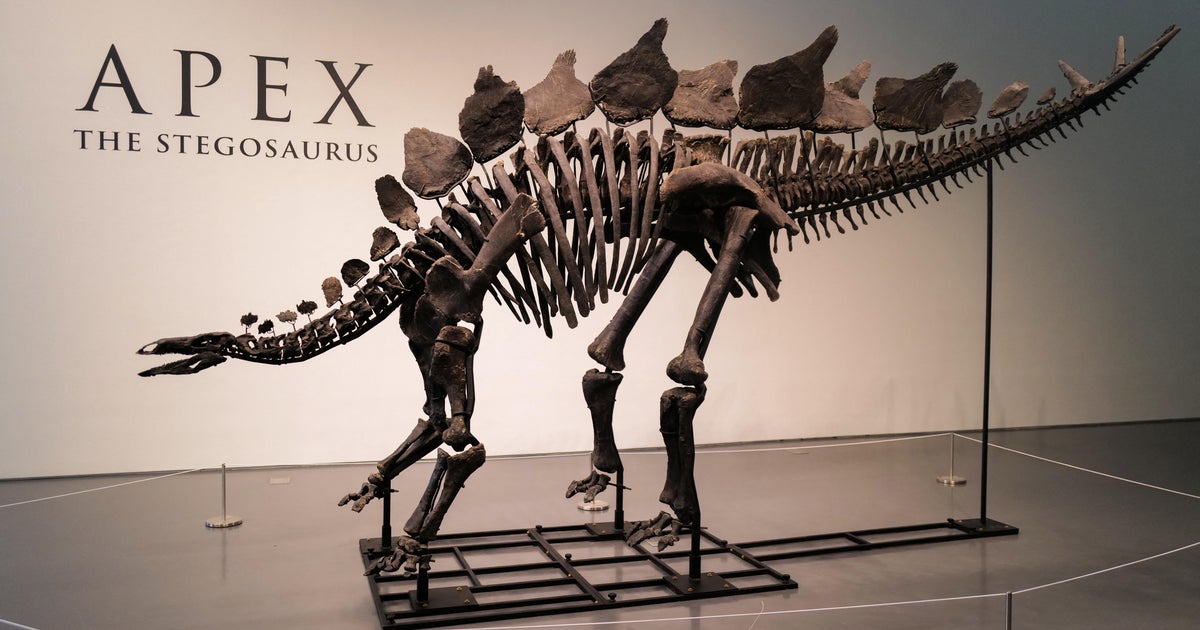CBS News
Banana duct-taped to wall sells for $6.2 million at NYC art auction

NEW YORK — A piece of conceptual art consisting of a simple banana, duct-taped to a wall, sold for $6.2 million at an auction in New York on Wednesday, with the winning bid coming from a prominent cryptocurrency entrepreneur.
“Comedian,” by Italian artist Maurizio Cattelan, was a phenomenon when it debuted in 2019 at Art Basel Miami Beach, as festivalgoers tried to make out whether the single yellow piece of fruit affixed to a white wall with silver duct tape was a joke or cheeky commentary on questionable standards among art collectors. At one point, another artist took the banana off the wall and ate it.
The piece attracted so much attention that it had to be withdrawn from view. But three editions sold for between $120,000 and $150,000, according to the gallery handling sales at the time.
Eduardo Munoz Alvarez / AP
Cryptocurrency platform founder purchases “Comedian”
Five years later, Justin Sun, founder of cryptocurrency platform TRON, has now paid more than 40 times that higher price point at the Sotheby’s auction. Or, more accurately, Sun purchased a certificate of authenticity that gives him the authority to duct-tape a banana to a wall and call it “Comedian.”
The piece attracted heavy attention at the busy auction at Sotheby’s, with attendees in the crowded room holding up phones to take photos as two handlers wearing white gloves stood at both sides of the banana.
Bidding started at $800,000 and within minutes shot up to $2 million, then $3 million, then $4 million, and higher, as the auctioneer, Oliver Barker, joked “Don’t let it slip away.”
“Don’t miss this opportunity,” Barker said. “These are words I’ve never thought I’d say: Five million dollars for a banana.”
The final hammer price announced in the room was $5.2 million, which didn’t include the about $1 million in auction house fees, paid by the buyer.
In a statement, Sun said the piece “represents a cultural phenomenon that bridges the worlds of art, memes, and the cryptocurrency community.” But he said the latest version of “Comedian” won’t last long.
“Additionally, in the coming days, I will personally eat the banana as part of this unique artistic experience, honoring its place in both art history and popular culture,” Sun said.
Sotheby’s calls Cattelan “among Contemporary Art’s most brilliant provocateurs.”
“He has persistently disrupted the art world’s status quo in meaningful, irreverent, and often controversial ways,” the auction house said in a description of “Comedian.”
Magritte painting sells for record $121.2 million
The sale came a day after a painting by the Belgian surrealist René Magritte sold for $121.2 million, a record for the artist, at a separate auction.
“The Empire of Light,” an eerie nighttime streetscape below a pale blue daytime sky, sold Tuesday as part of Christie’s sale of the collection of interior designer Mica Ertegun, who died last year at age 97.
The sale lifts Magritte into the ranks of artists whose works have gone for more than $100 million at auction. Magritte is the 16th member of the club, which also includes Leonardo da Vinci, Pablo Picasso and Andy Warhol, according to the market analyst firm Artprice.
“The Empire of Light,” executed in 1954, was one of 17 versions of the same scene that Magritte painted in oil. Marc Porter, chairman of Christie’s Americas, called the sale “a historic moment in our saleroom.”
The $121.2 million price included the auction house’s fees. The buyer was a telephone bidder whose identity was not disclosed.
CBS News
In praise of Seattle-style teriyaki

Watch CBS News
Be the first to know
Get browser notifications for breaking news, live events, and exclusive reporting.
CBS News
Gazan chefs cook up hope and humanity for online audience

Renad Atallah is an unlikely internet sensation: a 10-year-old chef, with a repertoire of simple recipes, cooking in war-torn Gaza. She has nearly a million followers on Instagram, who’ve witnessed her delight as she unpacks parcels of food aid.
CBS News
We interviewed Renad via satellite, though we were just 50 miles away, in Tel Aviv. [Israel doesn’t allow outside journalists into Gaza, except on brief trips with the country’s military.]
“There are a lot of dishes I’d like to cook, but the ingredients aren’t available in the market,” Renad told us. “Milk used to be easy to buy, but now it’s become very expensive.”
I asked, “How does it feel when so many people like your internet videos?”
“All the comments were positive,” she said. “When I’m feeling tired or sad and I want something to cheer me up, I read the comments.”
We sent a local camera crew to Renad’s home as she made Ful, a traditional Middle Eastern bean stew. Her older sister Noorhan says they never expected the videos to go viral. “Amazing food,” Noorhan said, who added that her sibling made her “very surprised!”
After more than a year of war, the Gaza Strip lies in ruins. Nearly everyone has been displaced from their homes. The United Nations says close to two million people are experiencing critical levels of hunger.
Hamada Shaqoura is another chef showing the outside world how Gazans are getting by, relying on food from aid packages, and cooking with a single gas burner in a tent.
Shaqoura also volunteers with the charity Watermelon Relief, which makes sweet treats for Gaza’s children.
In his videos online, Shaqoura always appears very serious. Asked why, he replied, “The situation does not call for smiling. What you see on screen will never show you how hard life is here.”
Before dawn one recent morning in Israel, we watched the UN’s World Food Program load nearly two dozen trucks with flour, headed across the border. The problem is not a lack of food; the problem is getting the food into the Gaza Strip, and into the hands of those who desperately need it.
The UN has repeatedly accused Israel of obstructing aid deliveries to Gaza. Israel’s government denies that, and claims that Hamas is hijacking aid.
“For all the actors that are on the ground, let the humanitarians do their work,” said Antoine Renard, the World Food Program’s director in the Palestinian territories.
I asked, “Some people might see these two chefs and think, well, they’re cooking, they have food.”
“They have food, but they don’t have the right food; they’re trying to accommodate with anything that they can find,” Renard said.
Even in our darkest hour, food can bring comfort. But for many in Gaza, there’s only the anxiety of not knowing where they’ll find their next meal.
For more info:
Story produced by Mikaela Bufano. Editor: Carol Ross.
See also:
“Sunday Morning” 2024 “Food Issue” recipe index
Delicious menu suggestions from top chefs, cookbook authors, food writers, restaurateurs, and the editors of Food & Wine magazine.
CBS News
A study to devise nutritional guidance just for you

It’s been said the best meals come from the heart, not from a recipe book. But at this USDA kitchen, there’s no pinch of this, dash of that, no dollops or smidgens of anything. Here, nutritionists in white coats painstakingly measure every single ingredient, down to the tenth of a gram.
Sheryn Stover is expected to eat every crumb of her pizza; any tiny morsels she does miss go back to the kitchen, where they’re scrutinized like evidence of some dietary crime.
Stover (or participant #8180, as she’s known) is one of some 10,000 volunteers enrolled in a $170 million nutrition study run by the National Institutes of Health. “At 78, not many people get to do studies that are going to affect a great amount of people, and I thought this was a great opportunity to do that,” she said.
CBS News
It’s called the Nutrition for Precision Health Study. “When I tell people about the study, the reaction usually is, ‘Oh, that’s so cool, can I do it?'” said coordinator Holly Nicastro.
She explained just what “precise” precisely means: “Precision nutrition means tailoring nutrition or dietary guidance to the individual.”
The government has long offered guidelines to help us eat better. In the 1940s we had the “Basic 7.” In the ’50s, the “Basic 4.” We’ve had the “Food Wheel,” the “Food Pyramid,” and currently, “My Plate.”
CBS News
They’re all well-intentioned, except they’re all based on averages – what works best for most people, most of the time. But according to Nicastro, there is no one best way to eat. “We know from virtually every nutrition study ever conducted, we have inner individual variability,” she said. “That means we have some people that are going to respond, and some people that aren’t. There’s no one-size-fits-all.”
The study’s participants, like Stover, are all being drawn from another NIH study program called All Of Us, a massive undertaking to create a database of at least a million people who are volunteering everything from their electronic health records to their DNA. It was from that All of Us research that Stover discovered she has the gene that makes some foods taste bitter, which could explain why she ate more of one kind of food than another.
Professor Sai Das, who oversees the study at Tufts University, says the goal of precision nutrition is to drill down even deeper into those individual differences. “We’re moving away from just saying everybody go do this, to being able to say, ‘Okay, if you have X, Y and Z characteristics, then you’re more likely to respond to a diet, and somebody else that has A, B and C characteristics will be responding to the diet differently,'” Das said.
It’s a big commitment for Stover, who is one of 150 people being paid to live at a handful of test sites around the country for six weeks – two weeks at a time. It’s so precise she can’t even go for a walk without a dietary chaperone. “Well, you could stop and buy candy … God forbid, you can’t do that!” she laughed.
While she’s here, everything from her resting metabolic rate, her body fat percentage, her bone mineral content, even the microbes in her gut (digested by a machine that essentially is a smart toilet paper reading device) are being analyzed for how hers may differ from someone else’s.
Nicastro said, “We really think that what’s going on in your poop is going to tell us a lot of information about your health and how you respond to food.”
CBS News
Stover says she doesn’t mind, except for the odd sounds the machine makes. While she is a live-in participant, thousands of others are participating from their homes, where electronic wearables track all kinds of health data, including special glasses that record everything they eat, activated when someone starts chewing. Artificial intelligence can then be used to determine not only which foods the person is eating, but how many calories are consumed.
This study is expected to be wrapped up by 2027, and because of it, we may indeed know not only to eat more fruits and vegetables, but what combination of foods is really best for us. The question that even Holly Nicastro can’t answer is, will we listen? “You can lead a horse to water; you can’t make them drink,” she said. “We can tailor the interventions all day. But one hypothesis I have is that if the guidance is tailored to the individual, it’s going to make that individual more likely to follow it, because this is for me, this was designed for me.”
For more info:
Story produced by Mark Hudspeth. Editor: Ed Givnish.
“Sunday Morning” 2024 “Food Issue” recipe index
Delicious menu suggestions from top chefs, cookbook authors, food writers, restaurateurs, and the editors of Food & Wine magazine.













